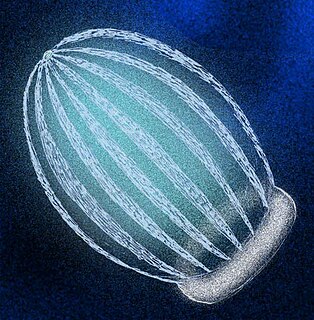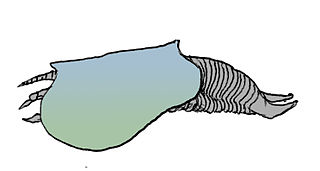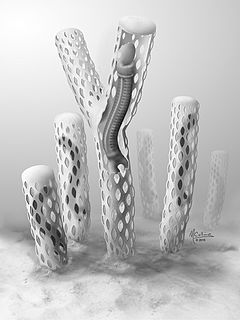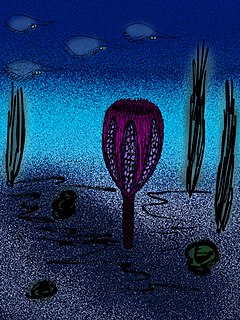
Ctenorhabdotus capulus is an extinct species of ctenophore, known from the Burgess shale in British Columbia, Canada. It is approximately 515 to 505 million years old and was equipped with 24 comb rows, three times as many as known from modern ctenophores. 5 specimens of Ctenorhabdotus are known from the Greater Phyllopod bed, where they comprise < 0.1% of the community.

Marpolia has been interpreted as a cyanobacterium, but also resembles the modern cladophoran green algae. It is known from the Middle Cambrian Burgess shale and Early Cambrian deposits from the Czech Republic. It comprises a dense mass of entangled, twisted filaments. It may have been free-floating or grown on other objects, although there is no evidence of attachment structures. 40 specimens of Marpolia are known from the Greater Phyllopod bed, where they comprise 0.08% of the community.
Dalyia is a pterobranch known from the middle Cambrian Burgess shale. It was previously interpreted as a red alga. It has smooth or faintly lineated stems, which branch into up to four equal branches at branching points. 37 specimens of Dalyia are known from the Greater Phyllopod bed, where they comprise 0.07% of the community.

Branchiocaris is a Cambrian organism known from Burgess shale-type localities. 4 specimens of Branchiocaris are known from the Greater Phyllopod bed, where they comprise <0.1% of the community.

Plenocaris plena is a crustacean-like arthropod with a bivalved carapace, and is known from the Burgess shale and Chengjiang. 106 specimens of Plenocaris are known from the Greater Phyllopod bed, where they comprise 0.20% of the community.
Liangshanella is a genus of Cambrian bradoriid known from the Chengjiang biota and Burgess Shale. 6263 specimens of Liangshanella are known from the Greater Phyllopod bed, where they comprise 11.9% of the community.
Morania is a genus of cyanobacterium preserved as carbonaceous films in the Middle Cambrian Burgess Shale. it is present throughout the shale; 2580 specimens of Morania are known from the Greater Phyllopod bed, where they comprise 4.90% of the community. It is filamentous, forms sheets, and resembles the modern cyanobacterium Nostoc. It would have had a role in binding the sediment, and would have been a food source for such organisms as Odontogriphus and Wiwaxia.
The Phyllopod bed, designated by USNM locality number 35k, is the most famous fossil-bearing member of the Burgess Shale fossil Lagerstätte. It was quarried by Charles Walcott from 1911–1917, and was the source of 95% of the fossils he collected during this time; tens of thousands of soft-bodied fossils representing over 150 genera have been recovered from the Phyllopod bed alone.
Chaunograptus is a genus of putative graptolite known from the Middle Cambrian Burgess Shale. 11 specimens of Chaunograptus are known from the Greater Phyllopod bed, where they comprise 0.02% of the community.
Ehmaniella is a genus of trilobite known from the Middle Cambrian Burgess Shale. 392 specimens of Ehmaniella are known from the Greater Phyllopod bed, where they comprise 0.74% of the community.
Fieldospongia is a genus of sea sponge known from the Middle Cambrian Burgess Shale. Just five specimens of Fieldospongia are known from the Greater Phyllopod bed, where they comprise less than 0.1% of the community.
Mackenzia is an elongated bag-like animal known from the Middle Cambrian Burgess Shale. It attached directly to hard surfaces, such as brachiopod shells. 14 specimens of Mackenzia are known from the Greater Phyllopod bed, where they comprise <0.1% of the community. Mackenzia was originally described by Charles Walcott in 1911 as a holothurian echinoderm. Later, Mackenzia is thought to be a cnidarian and appears most similar to modern sea anemones.

Molaria is a genus of Cambrian arthropod, the type species M. spinifera is known from the Middle Cambrian Burgess Shale. 144 specimens of Molaria are known from the Greater Phyllopod bed, where they comprise 0.27% of the community. A second species M. steini was described from the Sirius Passet in Greenland in 2017.

Oesia disjuncta is a monospecific genus known from the Middle Cambrian Burgess Shale. 1147 specimens of Oesia are known from the Greater Phyllopod bed, where they comprise 2.18% of the community. Despite some similarities to the chaetognaths, its affinity is unknown, though recent data suggest it may be affiliated with hemichordates.
Paterina is a genus of brachiopods known from the Middle Cambrian Burgess Shale. 18 specimens of Paterina are known from the Greater Phyllopod bed, where they comprise 0.03% of the community.

Petaloptyon danei is a goblet-shaped hexactinellid sponge known from rare fragments from the Middle Cambrian Burgess Shale. A few specimens of Petaloptyon are known from the Greater Phyllopod bed, where they comprise under 0.01% of the community.

Oryctocephalus is a genus of trilobite known from the Middle Cambrian Burgess Shale. 24 specimens of Oryctocephalus are known from the Greater Phyllopod bed, where they comprise 0.42% of the community. This small- to medium-sized trilobite's major characteristics are prominent eye ridges, pleural spines, long genal spines, spines on the pygidium, and notably four furrows connecting pairs of pits on its glabella. Juvenile specimens have been found with only 5 or 6 thoracic segments and about one eighth of adult size, as well as about 2 mm wide.
Protospongia is a genus of Porifera known from the Middle Cambrian Burgess Shale. 102 specimens of Protospongia are known from the Greater Phyllopod bed, where they comprise 0.19% of the community.
Stephenoscolex is a genus of polychaete worm known from the Middle Cambrian Burgess Shale. 150 specimens of Stephenoscolex are known from the Greater Phyllopod bed, where they comprise 0.29% of the community. The genus was described by Conway Morris (1979) and re-examined by Eibye-Jacobsen (2004).

Diagoniella is a genus of sponge known from the Middle Cambrian Burgess Shale. 128 specimens of Diagoniella are known from the Greater Phyllopod bed, where they comprise 0.24% of the community.









